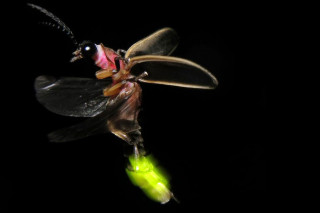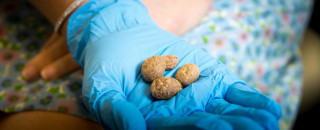NHMU Research Update, June 2018
NHMU's Louderback holds the tiny tubers of S. jamesii, the Four Corners potato.
By Randall Irmis
The Museum’s collections and research staff and students have been busy making ground-breaking discoveries over the past year, and I wanted to share some of these highlights.
Anthropology
Lisbeth Louderback's Four Corners Potato Project continues to test whether or not the Four Corners potato (Solanum jamesii) was transported and manipulated by people thousands of years ago. The unfolding story is revealing a deep history between Native Americans and this remarkable plant, challenging our understanding of plant domestication and food choices in the American West. Read more about this project from the University of Utah and in this article in the Proceedings of the National Academy of Sciences.
Tyler Faith and colleagues have discovered how past climate change in Kenya ~300,000 years ago affected the evolution of human culture and technology. Read more on the Museum's blog or this article in the journal Science.
Vertebrate Zoology
Eric Rickart, Shannen Robson, and colleagues report the first evidence of the Inyo shrew (Sorex tenellus) in Utah. This species was previously only known from a small area along the California-Nevada border, but recent work by NHMU has expanded its known range eastward through Nevada, and now into Utah. Read the First Record of Sorex tenellus from Utah.

Bill Newmark's research in tropical biodiversity hotspots on two continents demonstrates how habitat restoration in forest ecosystems can reduce the extinction rate. See Targeted habitat restoration can reduce extinction rates in fragmented forests.
Entomology
Christy Bills and colleagues continue to partner with citizen scientists to locate and document the spread of bioluminescing firefly populations throughout the state. Don't miss the temporary exhibit across from Utah Climate Challenge on the 2nd floor at the Museum. You can find out more, and become part of the project here.
Mycology
Bryn Dentinger and colleagues have discovered and described four species of mushroom new to science, from Brazil and Cameroon. See:
Two new Tylopilus species (Boletaceae) from Northeastern Atlantic Forest, Brazil
New species of Auritella (Inocybaceae) from Cameroon, with a worldwide key to the known species
Botany
Mitch Power and colleagues have assembled the first comprehensive global database of modern charcoal. This dataset provides a critical baseline for understanding past changes in natural and anthropogenic burning. Read Global Modern Charcoal Dataset (GMCD): A tool for exploring proxy-fire linkages and spatial patterns of biomass burning.
Elizabeth Johnson and her team have completed imaging of all 132,604 specimens in our Botany collection! You can search the collection and see the images here.
Paleontology
By precisely dating Triassic sediments from Petrified Forest National Park, a team including Randy Irmis and recent Ph.D. graduate Conny Rasmussen have demonstrated that gravitational interactions between Earth, Jupiter, and Venus have been stable for at least the past 215 million years. This affects the Earth's climate on a 400-thousand-year cycle and provides a robust and precise timescale for sediments deposited millions of years in the past. Read Empirical evidence for the stability of the 405-kiloyear Jupiter–Venus eccentricity cycle over hundreds of millions of years.
Postdoc alumnus Adam Huttenlocker (now at USC) recently described a new species of 130-million-year-old mammal from Utah that has surprising connections with Africa. You can see the original fossil on display in the Cedar Mountain Formation case in our Past Worlds Gallery. See Late-surviving stem mammal links the lowermost Cretaceous of North America and Gondwana.
Mineralogy
Dave Richardson has just published the fourth edition of his textbook 'Modern Ceramic Engineering'. Read more here.
Randall Irmis is the chief curator and the curator of paleontology at the Natural History Museum of Utah, a part of the University of Utah in Salt Lake City. Our mission is to illuminate the natural world and the place of humans within it. In addition to housing outstanding exhibits for the public, NHMU is a research museum. Learn more.
